-
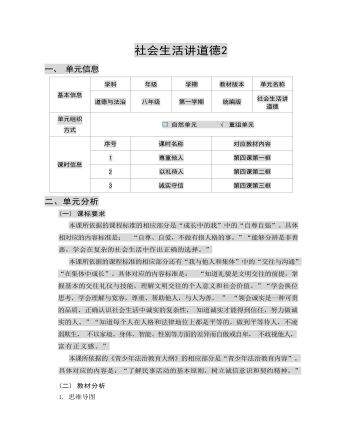
道德与法治八年级上册社会生活讲道德2作业设计
(一) 课标要求本课所依据的课程标准的相应部分是“成长中的我”中的“自尊自强”。具体 相对应的内容标准是: “自尊、自爱,不做有损人格的事。”“能够分辨是非善 恶,学会在复杂的社会生活中作出正确的选择。”本课所依据的课程标准的相应部分还有“我与他人和集体”中的“交往与沟通” “在集体中成长”。具体对应的内容标准是: “知道礼貌是文明交往的前提,掌 握基本的交往礼仪与技能,理解文明交往的个人意义和社会价值。”“学会换位 思考,学会理解与宽容,尊重、帮助他人,与人为善。 ” “领会诚实是一种可贵 的品质,正确认识社会生活中诚实的复杂性, 知道诚实才能得到信任,努力做诚 实的人。”“知道每个人在人格和法律地位上都是平等的,做到平等待人,不凌 弱欺生, 不以家境、身体、智能、性别等方面的差异而自傲或自卑, 不歧视他人, 富有正义感。”

道德与法治八年级上册社会生活讲道德作业设计
2. 内容内在逻辑本课由引言和三框内容组成。引言首先指出道德是社会关系的基石,是人际和谐的基础,说明本课与单元主题之间的关 联 。随后,点出本课的三个主题:尊重他人、以礼待人、诚实守信。第一框“尊重他人”,用学生常见的两个场景引导体验,导入新课 。学生在理解尊重含义的 同时,懂得尊重对个人和社会的价值和意义,懂得尊重的复杂性;进而引导学生学会如何在实 际生活做到尊重他人。第二框“以礼待人”,引导学生探讨文明有礼对个人和社会的意义,再扩展至“礼仪之邦”的 国家形象,懂得参加各种仪式体现了民族的尊严和国家的形象。第三框“诚实守信”,首先使学生明白诚信是一种道德规范,也是社会主义核心价值观在公 民个人层面的一个价值准则,在学生体会和认识到诚信对个人、社会等重要影响的基础上,引 导学生不断增强诚信意识,积极参加诚信建设。

道德与法治八年级上册维护国家利益2作业设计
2. 内容内在逻辑第八课《国家利益至上》设计了“国家好,大家才会好”“坚持国家利益至 上”两框内容,其立意在于帮助学生认识维护国家利益的重要性,正确认识国家 利益与人民利益的关系,提高维护国家利益的意识,树立正确的国家利益管,提 高辨析各种爱国观念和行为的能力,使自己的爱国情感更加理性、深沉。第九课《树立总体国家安全观》设计了“认识总体国家安全观”和“维护国 家安全”两框。 目的在于引导学生正确理解和全面把握我国安全形势面临的挑战 ,从小树立总体国家安全观, 自觉担负起维护国家安全的责任。第十课《建设美好祖国》设计了“关心国家发展”“天下兴亡,匹夫有责” 两框内容,其目的和意图在于帮助学生全面认识国家发展,从初中学生的角度认 识祖国发展,正视国家发展过程中的问题,理解自己与国家发展的密切关联,让 学生在关心祖国发展的同时,为将来投身于国家建设奠定认识基础。
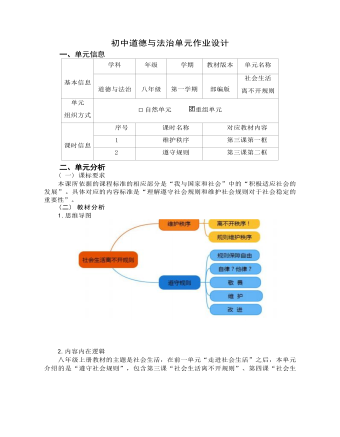
道德与法治八年级上册社会生活离不开规则作业设计
材料一 近年,外形酷似汽车的代步车大量上路,他们无牌、无照,走机动车道、 闯红灯,逆行、随意抢道、并线,不仅给城市交通带来压力,也造成不少安全隐患。材料二 斑马线上礼让行人已成为常态,大部分行人在遇到车辆礼让时,都能自 觉快速通过,但仍有部分行人“ 目中无车”——边过马路边看手机,或以散步的速度 缓慢通行,还有一些人在等候的机动车间任意穿行。让行司机表示:很苦恼也很无奈。(1) 你如何看待闯红灯、逆行、随意抢道、并线等交通陋习?(2) 针对部分行人“ 目中无车”,你会如何劝说他们遵守交通规则?(3)请你为杜绝交通陋习提两条合理化建议。(可从国家及相关部门、社会、公 民等角度提建议)12.阅读材料,回答下列问题。邮轮旅游作为现在新兴旅行方式之一,很多国人还并不习惯,有的游客因为不懂 邮轮规则而“露怯”,有的游客因为不遵守规则而影响到他人。
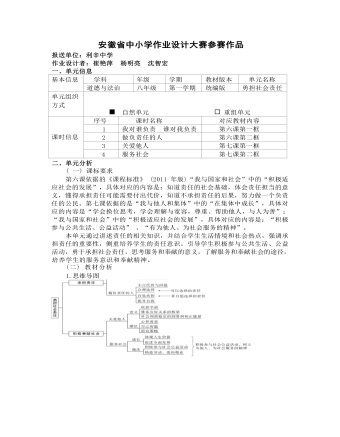
道德与法治八年级上册勇担社会责任11作业设计
二、单元分析( 一) 课标要求第六课依据的《课程标准》 (2011 年版)“我与国家和社会”中的“积极适 应社会的发展”,具体对应的内容是:知道责任的社会基础,体会责任担当的意 义,懂得承担责任可能需要付出代价,知道不承担责任的后果,努力做一个负责 任的公民。第七课依据的是“我与他人和集体”中的“在集体中成长”,具体对 应的内容是“学会换位思考,学会理解与宽容,尊重、帮助他人,与人为善”; “我与国家和社会”中的“积极适应社会的发展”,具体对应的内容是:“积极 参与公共生活、公益活动” 、“有为他人、为社会服务的精神”。本单元通过讲述责任的相关知识,并结合学生生活情境和社会热点,强调承 担责任的重要性,侧重培养学生的责任意识。引导学生积极参与公共生活、公益 活动,勇于承担社会责任,思考服务和奉献的意义,了解服务和奉献社会的途径, 培养学生的服务意识和奉献精神。

道德与法治八年级上册勇担社会责任17作业设计
答案解析:(1) 共同说明服务和奉献社会,需要我们青年担当责任的道理。(2) 服务和奉献社会,需要我们树立远大理想,努力学习,热爱劳动,培 养敬业精神,学会全力以赴、精益求精、追求卓越,为将来成为合格的社会主义 建设者做好准备;服务和奉献社会需要我们积极参与各种形式的社会公益活动; 服务和奉献社会还需要我们关心国家的发展,自觉投身社会实践,积极为祖国的 发展建言献策,努力肩负起实现中华民族伟大复兴的历史使命等。3、作业 3、作业分析:本题考查作业目标中“知道中学生奉献社会的途径,积极参与社 会活动,增强社会责任感”,创设情境取材于我县文明城市创建,创建中我县高 度重视,广大市民积极参与,学生自己、他们的父母及所在的社区都参与了创建, 学生对这一活动有一定的认知,也有参与的热情。但是,让学生自己组织一次志 愿活动还是有相当难度的。

道德与法治八年级上册勇担社会责任19作业设计
【做一位负责任的公民】各小组同学积极参与了上述问题的讨论, 并就如何做一位负责任的公民, 赢得社会对自 己的赞成票达成了一致建议。(4)请你写出该建议的内容。 答案:(1)陪伴孤寡老人、打扫卫生等。(2) 为灾区捐款; 义务植树; 回收废旧电池; 开展法律宣传; 帮助孤寡老人; 清除街头 小广告等。(3) 参加志愿者活动是主动承担社会责任的体现, 有利于锻炼自己的实践能力, 提升思 想道德素质, 促进自己的健康成长; 有利于赢得社会对自己的赞成票; 有利于良好社会 风气的形成,促进社会文明进步。(4) 认清责任, 树立起强烈的责任意识; 从我做起, 从现在做起, 从点滴小事做起, 养 成负责任的习惯; 学会在不同责任面前进行选择, 科学地安排时间, 学会统筹兼顾, 履 行好自己的职责; 自觉守法, 维护社会秩序; 服务社会, 奉献社会; 服务和建设自己所 在的社区;积极参与社会公益活动等。

道德与法治八年级上册勇担社会责任1作业设计
2. “对不起,我和同学不小心把您的车划了一道,这是我的电话号码,看 到后请与我联系。”2020 年 7 月 22 日,湖北卫辉市两名中学生不小心刮蹭了他 人汽车,主动给车主纸条留言。这一举动启示我们( )A.生活中一定不能犯错 B.要学会抵制不良诱惑C.行为不同,后果相同 D.对自己的行为后果负责3.爱因斯坦说:“我的精神生活和物质生活都依靠着别人的劳动,我必须尽 力以同样的分量来报偿我所领受了的和至今还在领受着的东西。 ”这启示我们 ( )①要学会感恩,主动帮助他人和服务社会②回报社会应当以别人对我们负责为前提③努力创造物质和精神财富是负责任的表现④关心他人、服务社会要坚持等量交换跟则A.①② B.①③ C.②④ D.③④ 4.疫情来袭,我们需要守望相助。面对“大考” ,我们需要共同守“沪”。安徽省援沪医疗队 1030 名核酸采样队员在上海连续奋战 36 天后,圆满完成援沪 抗疫任务启程返皖。这些“逆行者”的可敬之处在于 ( )①爱岗敬业,平凡中创造伟大②争先恐后,追求个人荣誉③勇担责任,不言代价与回报

道德与法治八年级上册勇担社会责任9作业设计
解析:C 此题考查服务社会,考查学生分析理解能力。解答此题需要结合所学,准确作答。 根据所学,分析题干关键词“志愿服务、献爱心”等可知,李晓和好友积极参与社会公益活动,服务社会、奉献社会,能营造良好的社会氛围, 也是做负责任公民的重要表现,①②④正确;从事志愿活动一方面承担更多的责 任,但往往也得到回报,如获得他人的肯定,③错误。故选 C。(核心素养:家国情怀 责任担当)10.古人云: “大事难事看担当,逆境顺境看襟度。 ”对于应负的责任,迎着风 险也要干好,不论回报,实践担当的精神,提升担当的能力,做到敢担当,能担 当,会担当,善担当。这启示我们 ( )①要义无反顾地担当应负的责任②履行社会责任要先看代价与回报③要提升自身素质,增强履行责任的能力④要将每一项社会责任都当作自己不可推卸的责任A. ①② B. ①③ C. ②④ D. ③④解析:B 此题考查自觉承担责任的要求,考查对材料的分析理解能力。解答本 题的关键是审清题意,据题意排除错误选项和干扰选项。积极承担责任是做人的基本要求,题干信息启示我们要积极承担责任。
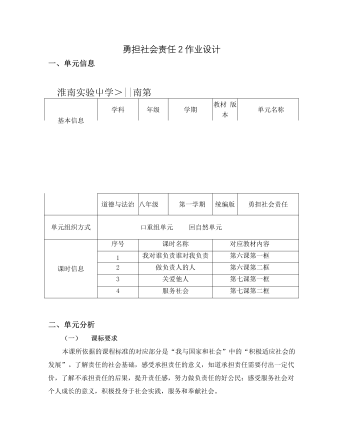
道德与法治八年级上册勇担社会责任2作业设计
一、单项选择题1. 假如你选择当一名教师,那便意味着你要教书育人;假如你选择做一名军人,那便意味着你要保家卫国;假如……这说明( )A. 我们可以根据需要选择承担或不承担责任B. 不同的角色要求承担不同的责任C. 责任对于每个人都是负担D. 每个人都应该承担相同的责任2. 芝加哥自然历史博物馆的卡尔?施密特在观察一条毒蛇时,突然遭其袭击,他顿时感到头晕,想要打电话,却发现电话坏了。他知道自己一定会死,但他坐 在桌前,记录自己死前的感受。卡尔在生命最后一刻默默守着工作岗位的举动, 表明( )A. 一个人无论什么时期都应对自己的一生负责B. 每个人在一生中所担负的责任往往是多重的C. 有知识和能力才能为社会贡献他的聪明才智D. 勇敢地承担责任首先要有强烈的责任意识
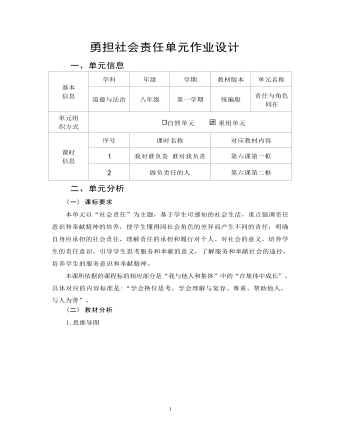
道德与法治八年级上册勇担社会责任7作业设计
一、单项选择题1.C 2.C 3.B二、非选择题4. 如:忠诚人民,勇敢无畏; 防疫攻坚, 白衣战士奋勇争先; 勇敢是你们的担当,奉献是你们的品质。5. (1) ①服务社会体现人生价值,才能得到人们的尊重和认可,实现我们 自身的价值;②服务社会能够促进我们全面发展,在服务社会的过程中,我们的 视野不断拓展,知识不断丰富,分析、解决问题的能力以及人际交往能力不断提 升,道德境界不断提高。(2) 本题属于开放性问题,列举的活动符合题意,言之有理即可。(3) ①努力学习科学文化知识,树立崇高而远大的理想,立志成才;②积 极参加社会实践活动,全面提高自身的素质;③积极承担社会责任,树立服务社 会、奉献社会的意识;④把个人前途和祖国命运紧密联系在一起,增强民族自信, 做自信中国人。从其他角度作答,符合题意,言之有理即可。
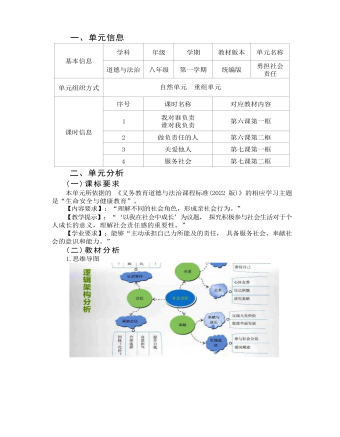
道德与法治八年级上册勇担社会责任8作业设计
2.内容内在逻辑本单元是八年级上册教材的第三单元,在逻辑结构上起着承上启下的作 用。在了解社会生活和社会规则的基础上,本单元将进一步引导学生明确社会责 任,积极主动服务奉献社会,所以本单元是对第一单元、第二单元内容的深化。 第四单元“维护国家利益”“担当历史使命”则进一步将社会责任扩展到国家层 面,是对本单元内容的进一步拓展。本单元以“社会责任”为主题,从学生发展需要和当前学生思想状况出 发,基于学生对责任、奉献等的理解和可感知的社会生活,帮助学生理解因社会 角色的差异而产生不同的责任,懂得对自己的行为负责,帮助学生理解承担责任 可能会获得回报,也可能只付出一定的代价,使学生理性对待承担责任过程中的 得与失。明确自身应承担的社会责任,理解责任的承担和履行对个人、对社会的 意义。引导学生感悟生活中无时无处不在的关爱,理解关爱他人是一种幸福,同 时也要讲究一定的艺术。引导学生思考服务和奉献的意义,了解服务和奉献社会 的途径,培养学生的服务意识和奉献精神。整个单元着重对学生进行正确价值观 的引导,有利于帮助学生更加主动地适应社会,实现个人的全面发展。

道德与法治八年级上册勇担社会责任18作业设计
2.内容内在逻辑本单元是人教八年级上册道德与法治学科第三单元的内容,在逻辑结构上起 着承上启下的作用,本单元包括两课四框内容。第六课“责任与角色同在”,两框分别是“我对谁负责 谁对我负责”、“做 负责任的人”:第一框“我对谁负责 谁对我负责”旨在引导学生学习社会责任,培养学生 责任意识,使学生认识到责任与角色同在,对自己的责任有明确的认识,增强责 任意识;能够随着角色的变换调整决策行为,能够对自己、对社会承担责任的人 心怀感激之情。第二框“做负责任的人”旨在让学生认识到承担责任意味着回报也意味着代价,要学会承担责任,更要为自己的选择负责,崇敬那些不言代价与回报且无私 奉献的人,努力做一个负责任的公民。第七课“积极奉献社会”,两框分别是“关爱他人”、“服务社会”。
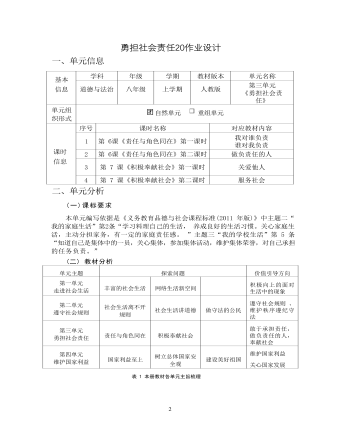
道德与法治八年级上册勇担社会责任20作业设计
本单元内容选至是八年级上册教材第三单元,在全书内容结构上起着承上启 下的作用。在了解社会生活和社会规则的基础上,本单元将进一步引导学生明确 社会责任,积极主动服务奉献社会。本单元是对第一单元、第二单元内容的深化。 本单元以“社会责任”为主题,基于学生可感知的社会生活,重点强调责任意识 和奉献精神的培养,使学生懂得因社会角色的差异而产生不同的责任,明确自身 应承担的社会责任,理解责任的承担和履行对个人、对社会的意义,培养学生的 责任意识。因此整个单元的核心任务是帮助学生认识到个人是社会的成员,社会 是由每个个体组成的。只有每个人承担责任,社会才能和谐发展;只有社会发展 了,才能为个人的成长提供良好的基础和条件。帮助学生理解承担责任的结果可 能会获得回报,也可能要付出一定的代价,懂得对自己的行为负责,使学生理性 对待承担责任过程中的得与失。引导学生感悟生活中无时无处不在的关爱,理解 关爱他人是一种幸福,同时也要讲究一定的艺术。引导学生思考服务和奉献的意 义,培养学生的服务意识和奉献精神。

道德与法治八年级上册勇担社会责任12作业设计
(四) 作业分析与设计意图这是一项基于素质教育导向的活动式课时作业设计,以培育学生健全人格为 目标。作业以志愿者活动为作业形式,让学生以负责任为主题积极参与到对社会 负责的志愿者活动中去,并且通过参与志愿者活动,真正感受社会,提升社会责 任感,也让他们真正理解责任的意义,健全人格,提升道德修养,在以后的生活 中,可以更积极地帮助他人,为社会为国家做出自己应有的贡献。六、单元质量检测( 一) 单元质量内容1.“熊孩子”在电梯里小便,妈妈让孩子写了一份检讨,发到业主群里给大伙 道歉,每天由孩子的父亲监督孩子打扫电梯一个月。妈妈意在教育“熊孩子”要( )①明是非,懂规矩 ②有教养,尊他人 ③敢担当,勇负责 ④享权利,尽义 务A.①③④ B.①②③ C.①②④ D.②③④2.教师以教书育人为己任,快递员以顾客满意为追求,消防员以救人灭火为 目标,警察以维护秩序、护人安危为使命……社会的发展离不开每一个人的努力。这表明 ( )A.社会和谐稳定需要每个人承的担相应的责任

道德与法治八年级上册勇担社会责任14作业设计
本单元是八年级上册教材的第三单元,在逻辑结构上起着承上启下的作用。从 学生发展的需要和当前学生思想现状出发,基于学生对责任、奉献等的理解和认知 状况,对其进行正确价值观的引导,有利于帮助学生更加主动地适应社会,实现个 人的全面发展。第六课“责任与角色同在”由引言和两框内容组成。引言概述了责任与角色的 关系以及承担责任对社会、民族和国家的意义,具有统领全课的作用。第一框“我 对谁负责,谁对我负责” ,主要是帮助学生了解什么是责任、责任的来源有哪些; 懂得在社会生活的舞台上,每个人都扮演着不同的角色,承担相应的责任;知道每 个人要对自己负责,也要对他人负责,同时其他人也在对自己负责。正是由于我们 每个人各负其责,个人才能获得充分发展,社会才能获得全面进步。第二框“做负 责任的人” ,主要是帮助学生认识到承担责任意味着要付出一定的代价,也会获得 回报,要学会作出合理的选择,并对自己的选择负责;对不是自愿选择但又必须做 的事要自觉承担、尽力做好,努力向履行社会责任却不言代价与回报的人学习。
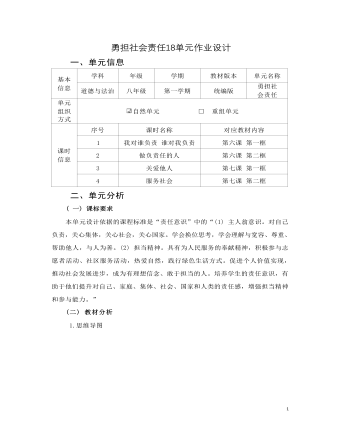
道德与法治八年级上册勇担社会责任18作业设计
2.内容内在逻辑本单元是人教八年级上册道德与法治学科第三单元的内容,在逻辑结构上起 着承上启下的作用,本单元包括两课四框内容。第六课“责任与角色同在”,两框分别是“我对谁负责 谁对我负责”、“做 负责任的人”:第一框“我对谁负责 谁对我负责”旨在引导学生学习社会责任,培养学生 责任意识,使学生认识到责任与角色同在,对自己的责任有明确的认识,增强责 任意识;能够随着角色的变换调整决策行为,能够对自己、对社会承担责任的人 心怀感激之情。第二框“做负责任的人”旨在让学生认识到承担责任意味着回报也意味着代价,要学会承担责任,更要为自己的选择负责,崇敬那些不言代价与回报且无私 奉献的人,努力做一个负责任的公民。第七课“积极奉献社会”,两框分别是“关爱他人”、“服务社会”。
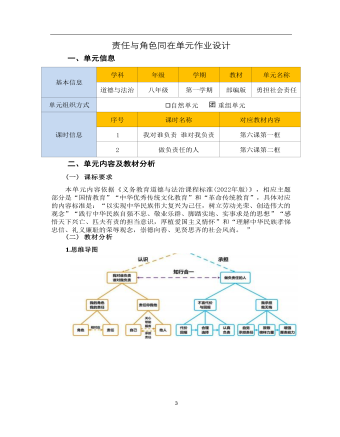
道德与法治八年级上册责任与角色同在作业设计
2.内容内在逻辑本单元《责任与角色同在》重点在责任意识的培养,为培养学生服务社会的 精神做好铺垫。第一框“我对谁负责 谁对我负责”,是从“认识责任”的角度厘清责任的 相关知识,包含责任的含义、责任的来源、责任与角色的关系,使学生明确自身 应承担的责任,理解承担责任对个人和社会的意义。第二框“做负责任的人”,是在第一框“认识责任”的基础之上,进一步探 讨“承担责任”。引导学生认识到承担责任意味着要付出一定的代价,也会获得 回报,要学会合理选择并对自己的选择负责。对于不是自愿选择但又必须做的事 要自觉承担、尽力做好,努力向履行社会责任却不计得失的人学习。综合来看,第一框主要帮助学生从思想上认清责任的来源以及责任与角色的 关系,明确责任是相互的。要成为负责任的人,关键还是要落实到行动中。第二 框则进一步引导学生从行动上提高责任意识, 主动承担责任。两框内容是有机统 一的。
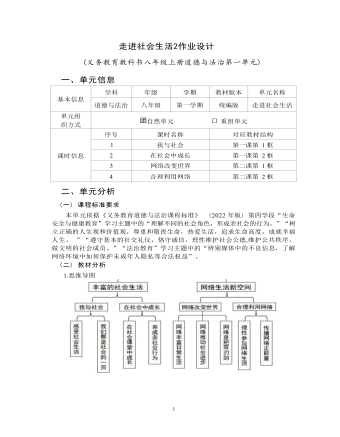
道德与法治八年级上册走进社会生活2作业设计
情景一 :小明发现利用手机不仅可以查阅资料 、学习新知 、广交朋友, 还可以聊微信 、 刷抖音 、 玩游戏 。 小明感叹: 一机在手 , 天 下我有!情景二: 在使用过程中 , 小明还发现 , 广告插件无处不在 , 明星八卦 扑面而来 , 各种信息真假难辨 。 游曳在五光十色的网海里 , 小 明 经 常 旷 课 , 成 绩 不 断 下 滑 , 越 来 越 不 愿 与 人 打 交 道 , 经 常宅在家里 ,沉迷游戏 ,最后还因为在网络上诈骗而被拘留。小明再一次感叹: 一机在手 , 毁我所有!请你根据情景,结合所学 内容 , 回答下列问题:(1)两 则材料共 同说 明了什 么? 请谈谈你对 “ 一机在手 , 毁我所有 ” 的理解 。 (6 分)(2)对 比两则材料 , 你 能得 到 哪些启示? (三个方面 即可 ) (6 分)【心系社会 公益有我】12. ( 18 分 ) “海 阔凭鱼跃 ,天 高任鸟飞 。 ”置 身于前所未有 的广 阔天地, 我们要主动融入绚丽多彩的社会生活 ,树立积极的生活态度 ,学会互 助关爱 、合作共享 ,承担起我们作为社会成 员的 责任 。某校八 (1) 班 同学在团支部带领下,开展了以“心系社会 · 公益有我”为主题的探究性学 习活动,请你参与并完成下列任务。
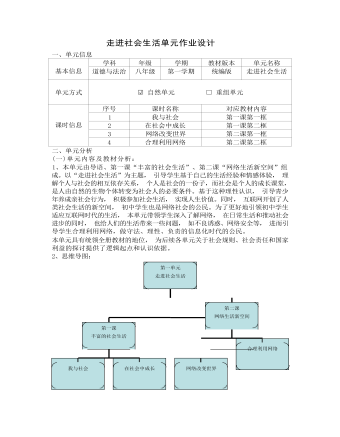
道德与法治八年级上册走进社会生活作业设计
(1)图片表现: 网络上信息很丰富。(2)面对网络海量的信息, 我们要注意浏览、寻找与学习和工作 有关的信息, 不应在无关信息面前停留, 不应在无聊信息是浪费精 力,更不可沉溺于网络,要学会“信息节食”10、某中学八年级 400 多名学生, 在田地里上了一堂生动有趣的劳 动体验实践课——插秧。据相关负责人介绍, 劳动体验实践课走进 田间地头, 可以丰富孩子们的课余生活, 拓展视野, 锻炼综合实践 能力。学生学插秧既可感受中华传统农耕文化的魅力, 体验农民劳 作的艰辛生活, 也让他们悟出“锄禾日当午, 汗滴禾下土”的真实 意义。(1)亲社会行为有哪些意义?(2)请列举两个你生活中的亲社会行为。(3) 中学生怎样才能养成亲社会行为?设计意图:本题设计意图在于结合实际事例, 引导学生对事例进行讨论, 分析, 促使学生能够理性对待,培养学生理论联系实际的能力参考答案:(1) 有利于我们养成良好的行为习惯,塑造健康的人格,形成正 确的价值观念,获得他人和社会的接纳与认可。(2) 当志愿者,参加公益活动。





















